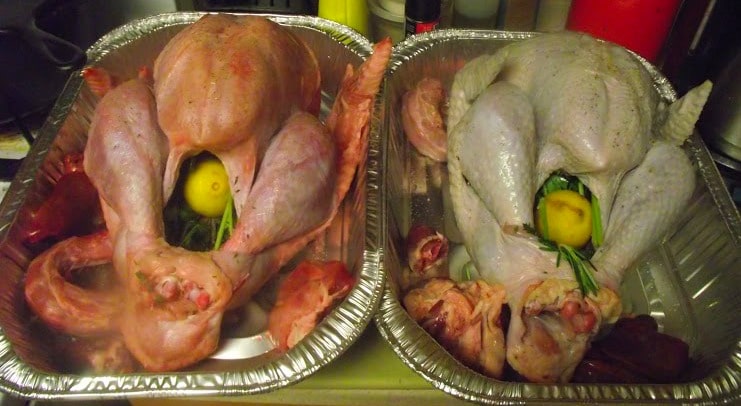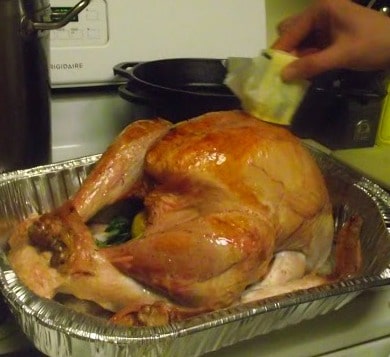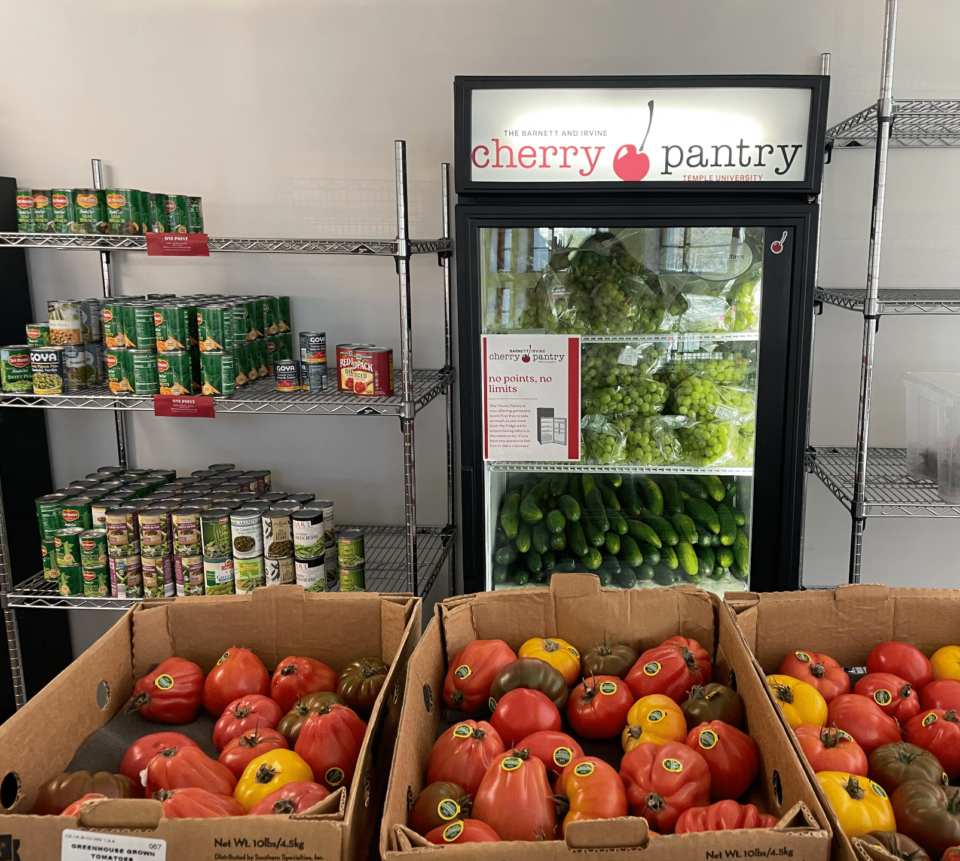Each year, the holiday season is kicked off in arguably the greatest way possible: surrounded by friends and family and pigging out on some seriously good food.
Some families are steadfast in their traditions, while others like to try out the hot new recipe they read about in the recent issue of Bon Appetit. So, in this test kitchen, there was both a traditionally roasted turkey as well as a bird that has been brined for a proportionate amount to its weight. To brine or not to brine? That was the question.
Brining is a preservation method by which the product is soaked in a mixture of salt, water and seasoning that causes the cooked meat to retain more moisture. Brining hydrates the muscle tissue before cooking and allows the cells to hold on to that extra water while they are cooked.
Some of the best salt to use in a brine is kosher salt because it dissolves quickly, it is sold in big cartons and it has larger crystals. Harold McGee writes in On Food and Cooking: The Science of Lore and the Kitchen that a proper brining ratio should be 3–6% salt by weight of the meat you are cooking. A good generalization contains ½ a cup of salt and ¼ cup of sugar per gallon of water. I used one cup salt and ½ cup sugar.
It is important to dissolve your sugar and salt before adding your meat, which requires heating your water. It is also important that the brine is cold when adding the meat, which means preparing your brine a while before you actually add the meat.
A simple way to do this is by heating only about half of your water to just below boiling, about 165° F, to dissolve the sugar and salt in then adding ice instead of cold water to bring the salt ratio back to the recommended level.
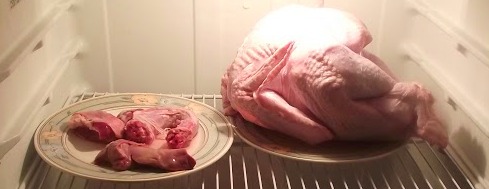 Once the salt and sugar dissolve, add the ice and allow the concoction to cool. Add your turkey and refrigerate for up to three days, depending upon the size of your bird. My 12-pounder was brined for about 20 hours.
Once the salt and sugar dissolve, add the ice and allow the concoction to cool. Add your turkey and refrigerate for up to three days, depending upon the size of your bird. My 12-pounder was brined for about 20 hours.
And finally, it was time to cook my birds. Alive less than 48 hours ago, this was some of the freshest meat a person could get without hunting or farming it personally. The first step, as ever, was preheating the oven to 425° F.
One thing that is great if you are able is to use a separate oven just for your turkey. This allows you to adjust the heat for your different sides without disturbing your turkey’s cooking. So, see which of your neighbors are going away this year! I got to use a friend’s oven a few houses away.
Recipe: Brined and Unbrined Turkey
Turkey ingredients:
- 1 lemon
- 1 bunch fresh rosemary
- 1 bunch fresh thyme
- 1 bunch fresh parsley
- 8 Tbsp butter (optional)
- salt and pepper to taste
Method:
I began by removing the giblets and putting them in my aluminum pans with my turkeys. The next step was stuffing my birds with fresh herbs and half of the lemon. The other half was squeezed over the entire turkey, along with the desired amount of salt and pepper.
With both of my ovens preheated, I simply put in my bird and set my timer for 20 minutes. I like to run the butter over the skin every twenty minutes. This allows the skin to crisp up without getting the soggy pools that come from placing pads of butter over the skin.
So, butter, 20 minutes, butter, 20 minutes. When the skin reached my desired crispness, I covered the bird with aluminum foil and reduced the oven’s temperature to 350° F. If you opt not to butter your skin, this usually happens by about 40 minutes. You don’t want your turkey uncovered in such heat for long as it loses more moisture that way.
I also removed the giblets at this time.
With the turkey covered, I continued to butter and begin to take the internal temperature every 20 minutes. Turkeys cook at approximately 15–20 minutes per pound, and my roasted bird was done in three hours. My brined bird cooking down the street took nearly four hours, so I used the extra time to make a simple gravy with the liver.
I poured the excess juice from my roasted turkey into a large saucepan and added the liver, which I had chopped coarsely, over a medium-high heat. I whisked for about five minutes while the liquid came to a boil then reduced the heat and let the gravy simmer for 20 minutes, whisking occasionally.
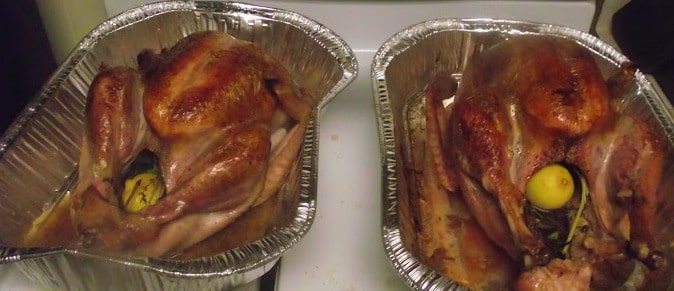
When the brined turkey was finished, I strained the gravy to get rid of any large liver bits, and carved up the birds, put them on separate plates to distinguish the different cooking methods, and served them in a blind taste test.
The Verdict: To Brine or Not to Brine
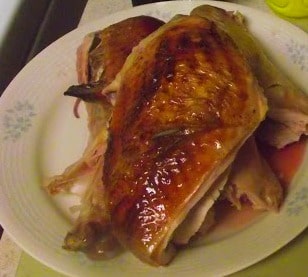 The verdict: people preferred the white meat from the roasted fresh turkey and the dark meat from the brined fresh turkey.
The verdict: people preferred the white meat from the roasted fresh turkey and the dark meat from the brined fresh turkey.
Both breasts were moist, and though the brined was jucier and the roasted had a less pleasing texture, the overall flavor of the roasted breast was better.
As for the thighs, it was the texture of the brined turkey that won over the taste buds. Everything was spot-on from texture to flavor to level of moisture. It seemed as though the thighs had absorbed more of the peppercorns that were in the brine than had the breast, which complemented their naturally more robust flavor.
In the end, the question remained as to whether it is better to brine a fresh turkey or to let the oven do its thing. Both turkeys were moist, flavorful, tender and out-of-this-world fresh. While a previously frozen bird may want the extra moisture from a few days of brining, a fresh turkey shines alone.
Explore Christy’s visit to Downingtown’s Howe Turkey Farm—where she sourced her turkeys—on DowningtownDish.com.
- Photography: Gwendolyn Moore

